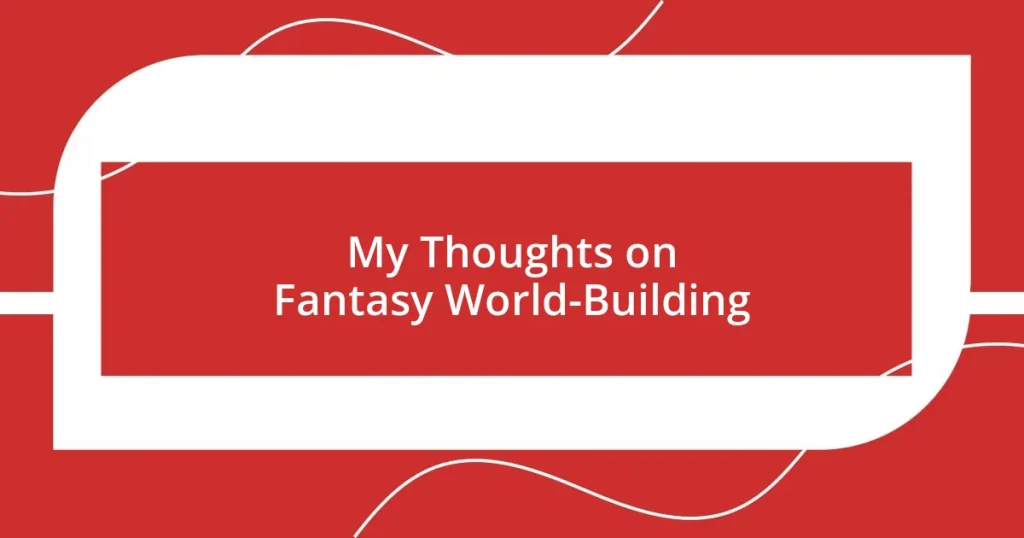Key takeaways:
- Fantasy world-building involves creating an interconnected tapestry of geography, culture, and magic, which enhances narrative depth.
- Unique cultures and economic systems significantly influence characters’ choices and societal dynamics, driving narratives forward.
- Immersive settings are enriched by sensory details, cultural elements, and the impact of conflict, fostering emotional connections with readers.
- Developing a magic system intertwined with societal structures explores themes of power and privilege, making magic an integral part of character lives.
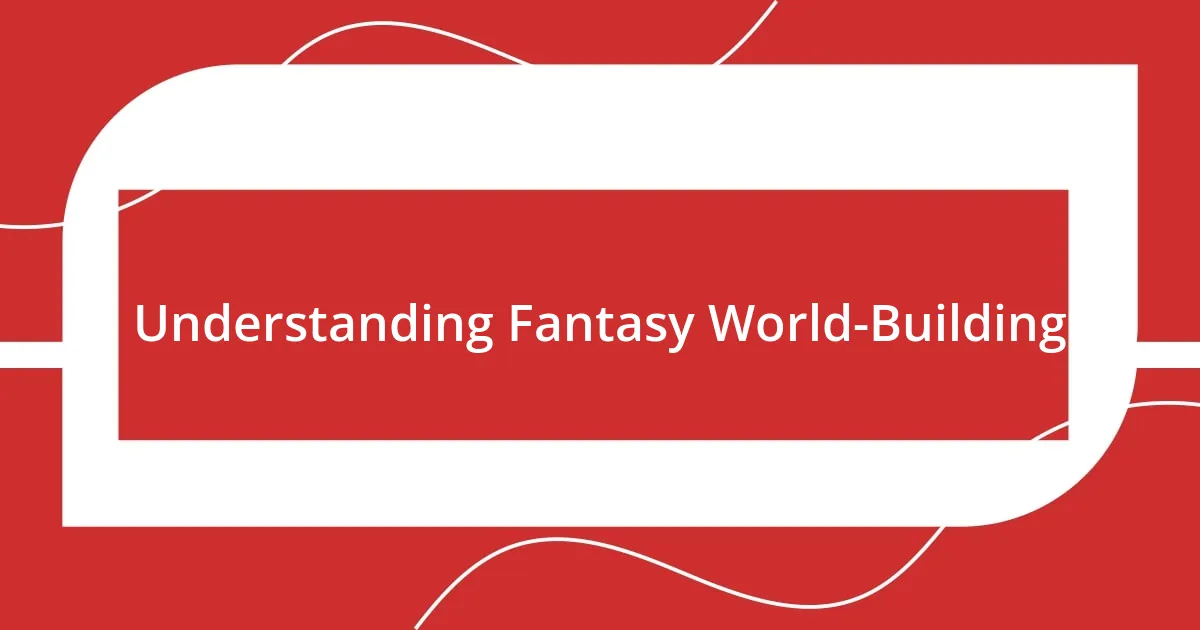
Understanding Fantasy World-Building
When I think about fantasy world-building, I recall the excitement of immersing myself in an entirely different universe. I remember crafting my own realm filled with lush forests and sprawling kingdoms, and it felt like magic to breathe life into every detail. Do you ever find yourself losing track of time as you build your worlds? I know I have!
Understanding fantasy world-building isn’t just about geography or history; it’s about creating a sense of wonder and connectivity. For me, the lore and cultural elements are what truly make a world come alive. I once spent hours thinking about the traditions of a fictional race I had invented, and it deepened my appreciation for how they would interact with others.
Elements like magic systems, political structures, and societal norms add layers of complexity. It’s fascinating to see how each piece interlocks, shaping the narrative and characters as they navigate the challenges of their world. Have you ever considered how the rules of magic can reflect the values of a society? I believe this connection makes the world not just a backdrop, but a character in its own right.

Key Elements of World-Building
When diving into world-building, I’ve found a few key elements that truly anchor the experience. For me, geography and its diverse settings are a canvas on which narratives are painted. I vividly remember crafting a mountain range that served as a natural barrier, influencing trade routes and cultural exchanges. It reminded me of how our own world’s geography shapes our interactions and experiences.
Key Elements of World-Building:
- Geography: The layout of your world—mountains, rivers, and forests—shapes the societies that inhabit it.
- Magic System: Defining how magic works can build your world’s rules; I once created a magic system tied to the cycles of the moon, which impacted everything from agriculture to festivals.
- Cultural Norms: The beliefs, traditions, and customs of societies enrich the world; I recall creating a festival that celebrated the changing seasons, tying it to the characters’ emotional journeys.
- Political Structures: Governance models influence conflicts and alliances; thinking about how different races interact within political frameworks adds tension and depth.
- History and Lore: A compelling backstory can enliven the current events of your world, making readers invested in its past and future.
As I reflect on these elements, it becomes clear that each aspect interconnects seamlessly, forming a vibrant tapestry. The thrill of exploring how these factors interact brings the world to life in a way that constantly rekindles my excitement for storytelling!
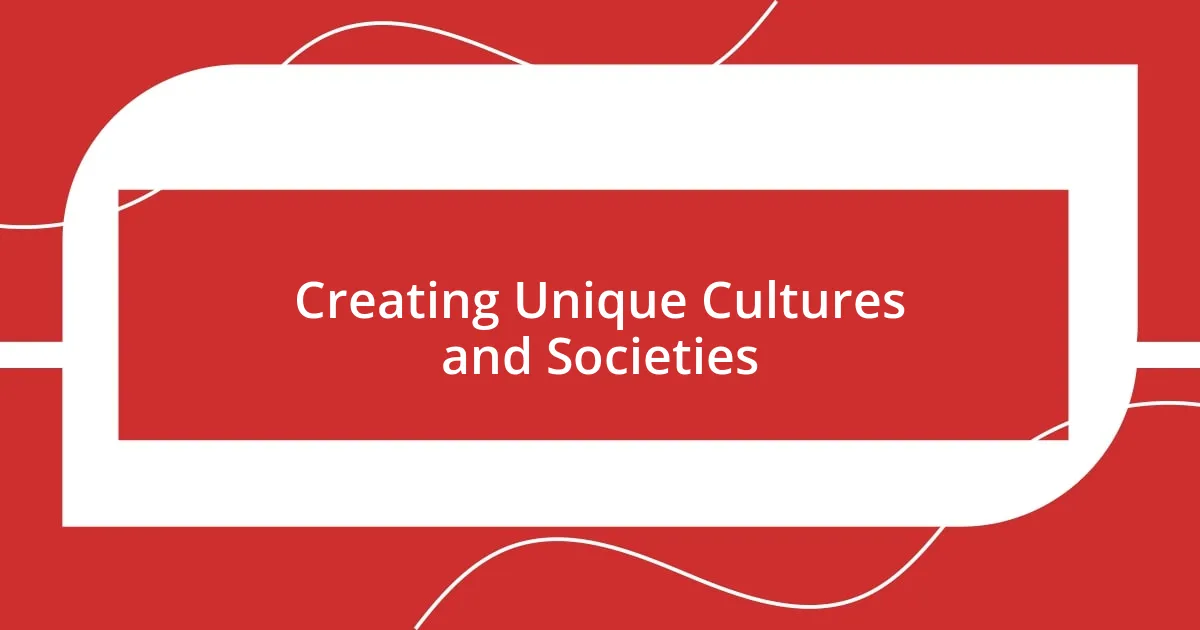
Creating Unique Cultures and Societies
Creating unique cultures and societies is one of the most exhilarating parts of fantasy world-building for me. I remember when I devised a society that valued storytelling as the highest form of art. People would gather around fires each night to share tales that shaped their history and morals. It made me ponder: what role does storytelling play in our lives? This reflection deepened my connection to the characters who emerged from this culture and how their values impacted their choices.
As I continued to develop this society, I contemplated its rituals and traditions. One memorable tradition involved a coming-of-age ceremony held during a lunar eclipse, where young adults would narrate their life stories. I found this to be a powerful moment that highlighted their connections to the past and future. It drives home the idea that unique customs can shape a community’s identity and provide insight into their worldview.
I’ve also observed how economic systems influence societal dynamics. In one of my stories, I crafted a barter system where traders valued goods based on their cultural significance. It led to unexpected conflicts—what one group prized, another deemed useless. It illustrated how varied perspectives can generate tension and drive narratives forward. The choices characters make in these unique societies often reflect their values, and that’s what makes fantasy truly compelling.
| Aspect | Description |
|---|---|
| Storytelling | Defined as an essential cultural practice that shapes values and morals. |
| Traditions | Unique ceremonies, such as coming-of-age rituals, strengthen communal bonds. |
| Economic Systems | A barter economy influences interactions based on cultural significance and values. |
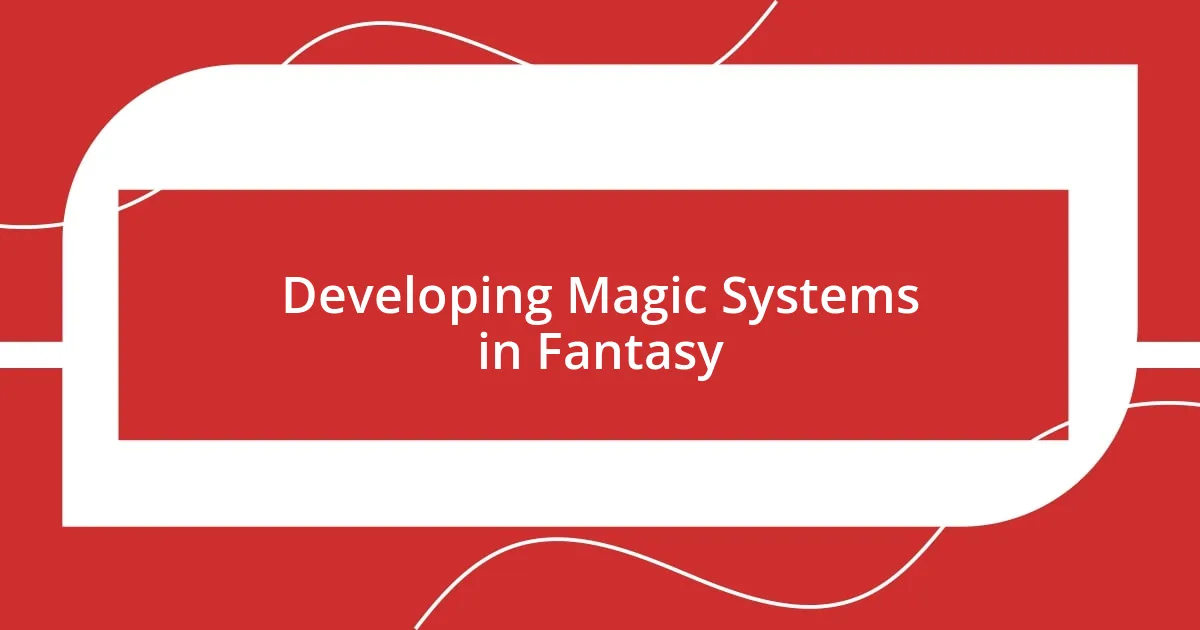
Developing Magic Systems in Fantasy
Developing a magic system is one of my favorite aspects of crafting a fantasy world. I’ve created magic that hinges on emotions, allowing practitioners to harness their feelings to cast spells. Can you imagine how powerful a character could become when their joy morphs into a dazzling display of light, but their anger conjures destructive forces? This interplay of emotions not only enriches the narrative but also highlights the human experiences that resonate deeply with readers.
The rules surrounding a magic system can shape the entire culture of your world. For instance, in one of my stories, I implemented strict laws that limited who could practice magic based on societal status. This decision sparked rebellion among the lower classes, igniting a rich backdrop of conflict and character development. I’ve found that by intertwining magic with societal structures, you can explore themes of power and privilege, making the magic feel like an integral part of the characters’ lives rather than a mere tool.
Another captivating element of magic systems is how they interact with the physical world. I once devised a scenario where magic could only be accessed at specific locations, such as ancient trees or sacred springs. This not only created a sense of pilgrimage for the characters but also instilled a deep reverence for nature. It made me reflect on our world and the places we hold sacred—what would it mean to protect these sites if they were the key to incredible power? Such questions can drive narratives forward, allowing readers to consider the connections between worlds real and imagined.
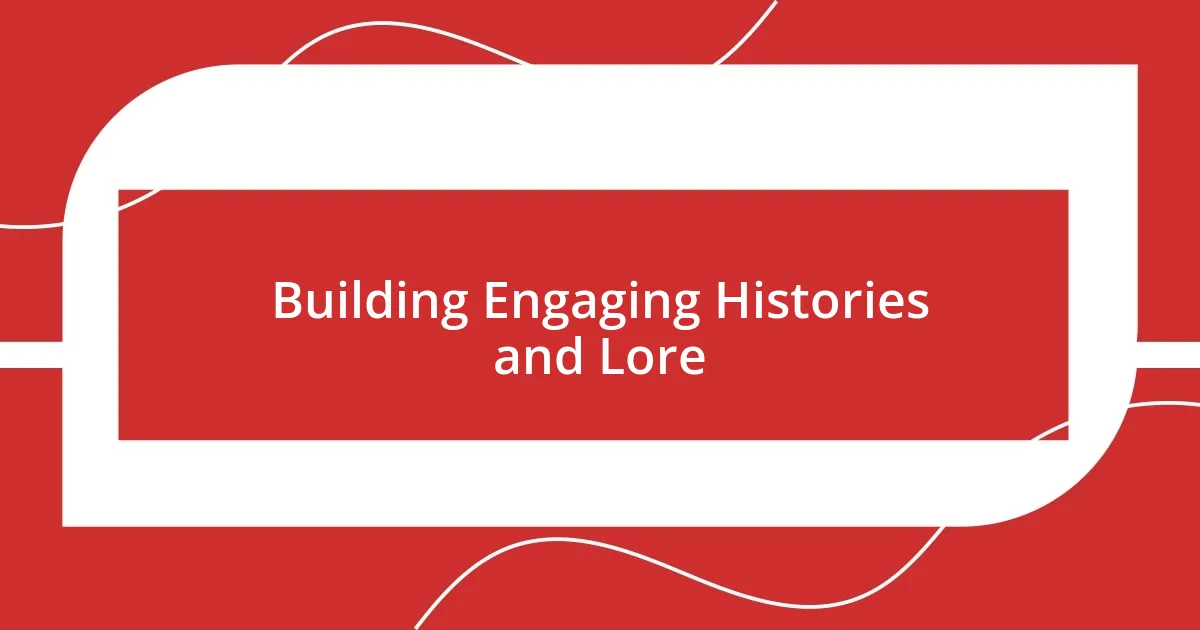
Building Engaging Histories and Lore
Crafting the histories and lore of a fantasy world always brings a sense of purpose to my storytelling. I vividly recall a time when I created an ancient kingdom that fell due to the hubris of its leaders. I found myself deeply invested in the tales of its rise and fall, wondering how such power can corrupt even the noblest. It reminded me that our past shapes who we are today, and this theme resonated strongly within the characters I developed.
In another project, I decided to infuse my world with a forgotten prophecy that foreshadowed the return of a hero. As I wove details about lost texts and the elation mixed with despair that came with hunting for their meaning, I realized how lore could create tension. I was captivated by the idea that hope can be a double-edged sword—leaving characters feeling inspired yet burdened at the same time. It’s a fascinating exploration of expectation versus reality; how often do we chase dreams only to find them fraught with complications?
Delving into the conflicts and alliances throughout my constructed histories often brings to light the human experience. I once introduced a long-standing feud between two rival families, both steeped in misunderstandings and grief. This lore not only enriched my characters’ backstories but also posed profound questions about the power of reconciliation: can love really overcome generations of animosity? Building histories that explore such intricate dynamics allows readers to see pieces of their own lives reflected in the stories I create, fostering a deeper connection to the narrative.
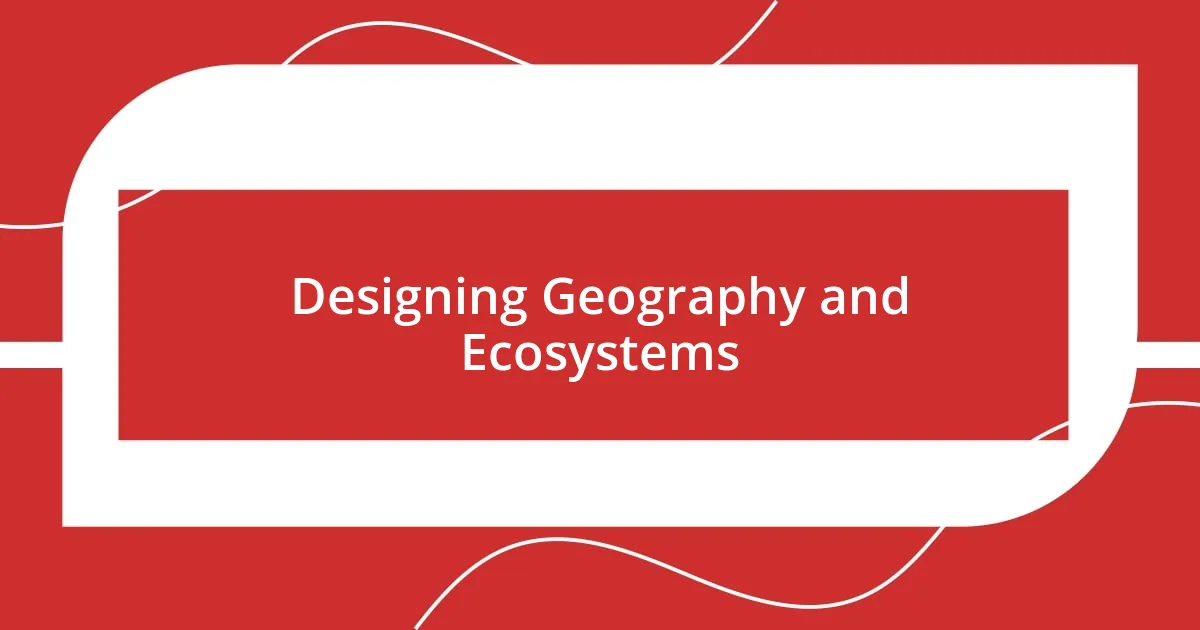
Designing Geography and Ecosystems
Designing the geography and ecosystems of a fantasy world truly excites me. When I created a mountainous region with verdant valleys overshadowed by snow-capped peaks, I felt an immense satisfaction witnessing how the landscape influenced the cultures that inhabited it. Have you ever considered how terrain shapes a character’s lifestyle? For instance, in my world, those living in the highlands relied on mountain goats for sustenance, while valley dwellers became skilled farmers, reflecting the natural resources unique to their surroundings.
I vividly recall mapping out a forest teeming with life and contradictions. Within this enchanting setting, I introduced bioluminescent plants that glowed at night, casting an ethereal light over the paths, while perilous creatures roamed just beyond the underbrush. This interplay between beauty and danger sparked my imagination. I often ask myself, how do such environments foster resilience or creativity in characters? The forest became a character in its own right, shaping the stories of those who navigated its depths and teaching valuable lessons about harmony with nature.
Creating distinct climates can also enhance the narrative tension. In one story, I designed a desolate desert where survival hinged on scarce water sources. The characters I developed there had to rely on external alliances and ingenuity, evoking strong emotions for both themselves and the readers. It made me reflect on our own world—what does it mean to embrace community or tackle impossible challenges? As I continue to weave together geography and ecosystems, I find myself constantly amazed by how they enrich character dynamics and the overarching plot.
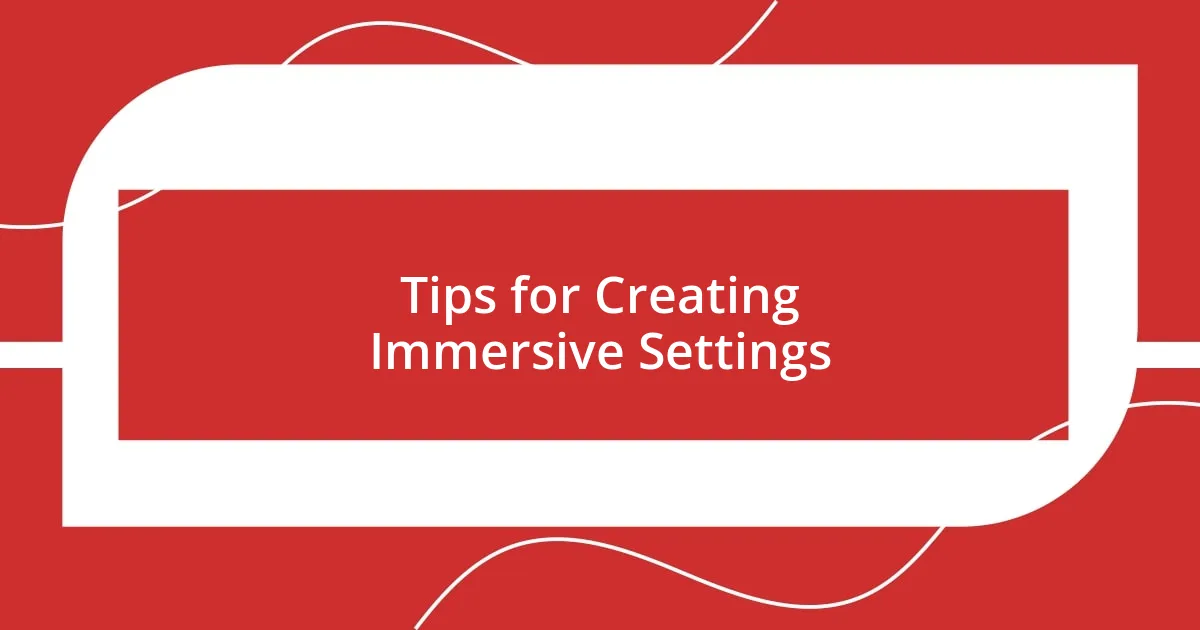
Tips for Creating Immersive Settings
Creating immersive settings has always been a passion of mine, and I’ve discovered that details truly make a difference. For instance, when developing a bustling marketplace, I didn’t just describe the colors and sounds; I imagined the scents—the spicy aroma of street food mingling with the earthy smell of fresh herbs. It struck me how such sensory details can transport readers, allowing them to feel the vibrancy of that world as if they were walking alongside the characters. What would your dream setting feel like?
Another tip I’ve learned is to embed cultural elements that reflect your world’s history. In one of my stories, I crafted a festival that honored the night sky, showcasing how that culture revered the stars. It was fascinating to observe how the characters’ interactions during the festivities brought their personalities to life, revealing layers of joy, rivalry, and tradition. This connection between setting and character can amplify the emotional resonance of the narrative. I often ponder how a single event can serve as a mirror to a society’s values; doesn’t it make you think about what celebrations are important in your own life?
Lastly, I’ve experienced the power of conflict in shaping environments. In a project where I placed a once-thriving city in the midst of a magical drought, the atmosphere transformed into one of despair. I wanted readers to visually feel the cracks in the pavement, the wilting blooms, and the hushed conversations among desperate citizens. By showing how external pressures alter a setting, I intended to captivate readers and inspire empathy for my characters. When a place reflects struggle, it invites readers to reflect on their own challenges, doesn’t it?










